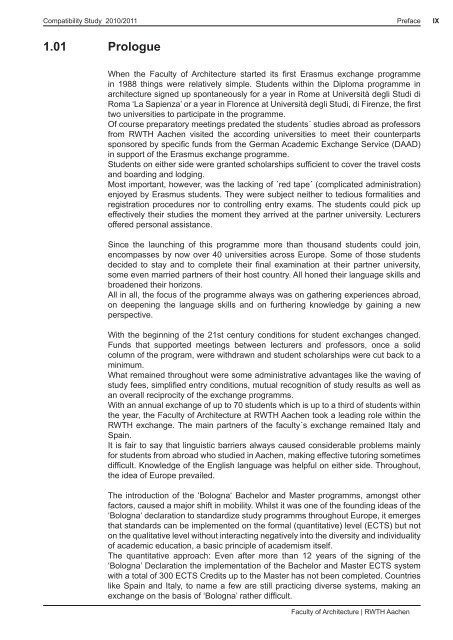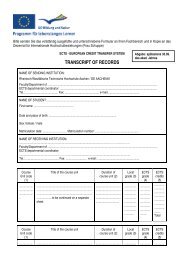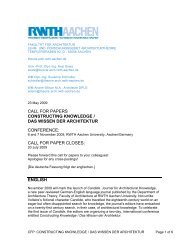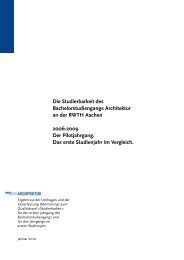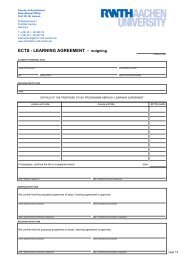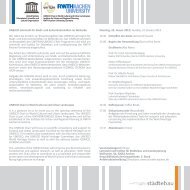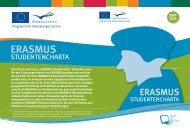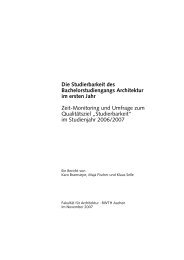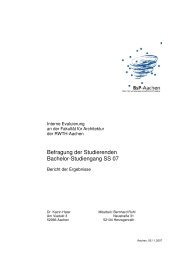Faculty of Architecture | RWTH Aachen
Faculty of Architecture | RWTH Aachen
Faculty of Architecture | RWTH Aachen
Create successful ePaper yourself
Turn your PDF publications into a flip-book with our unique Google optimized e-Paper software.
Compatibility Study 2010/2011 Preface IX<br />
1.01<br />
Prologue<br />
When the <strong>Faculty</strong> <strong>of</strong> <strong>Architecture</strong> started its first Erasmus exchange programme<br />
in 1988 things were relatively simple. Students within the Diploma programme in<br />
architecture signed up spontaneously for a year in Rome at Università degli Studi di<br />
Roma ‘La Sapienza’ or a year in Florence at Università degli Studi, di Firenze, the first<br />
two universities to participate in the programme.<br />
Of course preparatory meetings predated the students´ studies abroad as pr<strong>of</strong>essors<br />
from <strong>RWTH</strong> <strong>Aachen</strong> visited the according universities to meet their counterparts<br />
sponsored by specific funds from the German Academic Exchange Service (DAAD)<br />
in support <strong>of</strong> the Erasmus exchange programme.<br />
Students on either side were granted scholarships sufficient to cover the travel costs<br />
and boarding and lodging.<br />
Most important, however, was the lacking <strong>of</strong> ´red tape´ (complicated administration)<br />
enjoyed by Erasmus students. They were subject neither to tedious formalities and<br />
registration procedures nor to controlling entry exams. The students could pick up<br />
effectively their studies the moment they arrived at the partner university. Lecturers<br />
<strong>of</strong>fered personal assistance.<br />
Since the launching <strong>of</strong> this programme more than thousand students could join,<br />
encompasses by now over 40 universities across Europe. Some <strong>of</strong> those students<br />
decided to stay and to complete their final examination at their partner university,<br />
some even married partners <strong>of</strong> their host country. All honed their language skills and<br />
broadened their horizons.<br />
All in all, the focus <strong>of</strong> the programme always was on gathering experiences abroad,<br />
on deepening the language skills and on furthering knowledge by gaining a new<br />
perspective.<br />
With the beginning <strong>of</strong> the 21st century conditions for student exchanges changed.<br />
Funds that supported meetings between lecturers and pr<strong>of</strong>essors, once a solid<br />
column <strong>of</strong> the program, were withdrawn and student scholarships were cut back to a<br />
minimum.<br />
What remained throughout were some administrative advantages like the waving <strong>of</strong><br />
study fees, simplified entry conditions, mutual recognition <strong>of</strong> study results as well as<br />
an overall reciprocity <strong>of</strong> the exchange programms.<br />
With an annual exchange <strong>of</strong> up to 70 students which is up to a third <strong>of</strong> students within<br />
the year, the <strong>Faculty</strong> <strong>of</strong> <strong>Architecture</strong> at <strong>RWTH</strong> <strong>Aachen</strong> took a leading role within the<br />
<strong>RWTH</strong> exchange. The main partners <strong>of</strong> the faculty´s exchange remained Italy and<br />
Spain.<br />
It is fair to say that linguistic barriers always caused considerable problems mainly<br />
for students from abroad who studied in <strong>Aachen</strong>, making effective tutoring sometimes<br />
difficult. Knowledge <strong>of</strong> the English language was helpful on either side. Throughout,<br />
the idea <strong>of</strong> Europe prevailed.<br />
The introduction <strong>of</strong> the ‘Bologna‘ Bachelor and Master programms, amongst other<br />
factors, caused a major shift in mobility. Whilst it was one <strong>of</strong> the founding ideas <strong>of</strong> the<br />
‘Bologna‘ declaration to standardize study programms throughout Europe, it emerges<br />
that standards can be implemented on the formal (quantitative) level (ECTS) but not<br />
on the qualitative level without interacting negatively into the diversity and individuality<br />
<strong>of</strong> academic education, a basic principle <strong>of</strong> academism itself.<br />
The quantitative approach: Even after more than 12 years <strong>of</strong> the signing <strong>of</strong> the<br />
‘Bologna’ Declaration the implementation <strong>of</strong> the Bachelor and Master ECTS system<br />
with a total <strong>of</strong> 300 ECTS Credits up to the Master has not been completed. Countries<br />
like Spain and Italy, to name a few are still practicing diverse systems, making an<br />
exchange on the basis <strong>of</strong> ‘Bologna’ rather difficult.<br />
<strong>Faculty</strong> <strong>of</strong> <strong>Architecture</strong> | <strong>RWTH</strong> <strong>Aachen</strong>


